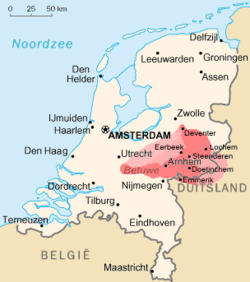Hamaland
| County of Hamaland | |||||
| Graafschap Hamaland (nl) | |||||
| Vassal of Carolingian Empire | |||||
| |||||
 The County of Hamaland | |||||
| Capital | Zutphen e.a. | ||||
| Political structure | Vassal | ||||
| Historical era | Middle Ages | ||||
| - | Established | 9th century | |||
| - | Disestablished | 11th century | |||
Hamaland (also Hameland) is a non-administrative region in the east of the Netherlands that is named after the Chamavi, a Germanic tribe that later merged into the confederation of the Franks. It is located east of the river IJssel and south of Salland (the original homeland of the Frankish Salii) and Twente (the original homeland of the Germanic Tuihanti). Hamaland and the Chamavi were in Late antiquity ruled by independent kings. Later the Chamavi were subdued by Carolingian Franks.
From the 9th century there was a Duchy of Hamaland, the rulers of which owned large parts of the middle, east and north of what is now the Netherlands. The same family also owned a large part of German Münsterland and more southerly estates, probably around Nassau. When the ruling Counts died out Hamaland became one of the core areas of the Dukes of Guelders, and thus became part of the Duchy of Guelders. Other lineages of the Hama-family became prominent in the Duchy of Cleve and the Bishoprics of Utrecht and Münster.
Nowadays Hamaland is part of the Dutch province Gelderland.